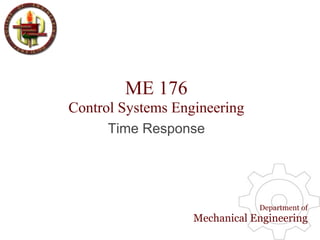
Lecture 8 Me 176 2 Time Response
- 1. ME 176 Control Systems Engineering Time Response Department of Mechanical Engineering
- 2. System Response with Additional Poles: Under certain conditions, a system with more than two poles or with zeros can be approximated as a second-order system that has just two complex "dominant poles". Department of Mechanical Engineering
- 3. System Response with Additional Poles: Department of Mechanical Engineering
- 4. System Response with Additional Poles: Under certain conditions, a system with more than two poles or with zeros can be approximated as a second-order system that has just two complex "dominant poles". How much larger should case 2 be to have effects of extra pole negligible and thus have second order analysis applicable to this type of system? Department of Mechanical Engineering
- 5. System Response with Zeros: Under certain conditions, a system with more than two poles or with zeros can be approximated as a second-order system that has just two complex "dominant poles". ---------------------------------> Zero : -3 ---------------------------------> Dominant Pole ---------------------------------> Zero : -5 ---------------------------------> Dominant Pole ---------------------------------> Zero : -10 ---------------------------------> Dominant Pole ---------------------------------> Zero :None ---------------------------------> Dominant Pole Department of Mechanical Engineering
- 6. System Response with Zeros: The closer the zero is to the dominant poles, the greater its effects on the transient response. As the zero moves away from the dominant poles, the response approaches that of the two pole system. Department of Mechanical Engineering
- 7. System Response with Zeros: Analysis: Derivative of Scale of original response Orginal Response Department of Mechanical Engineering
- 8. System Response with Pole-Zero cancellation: For a third-order transfer functions with a zero and a pole very close in value, both cancel to result in a second-order transfer function. ========== ========== Department of Mechanical Engineering
